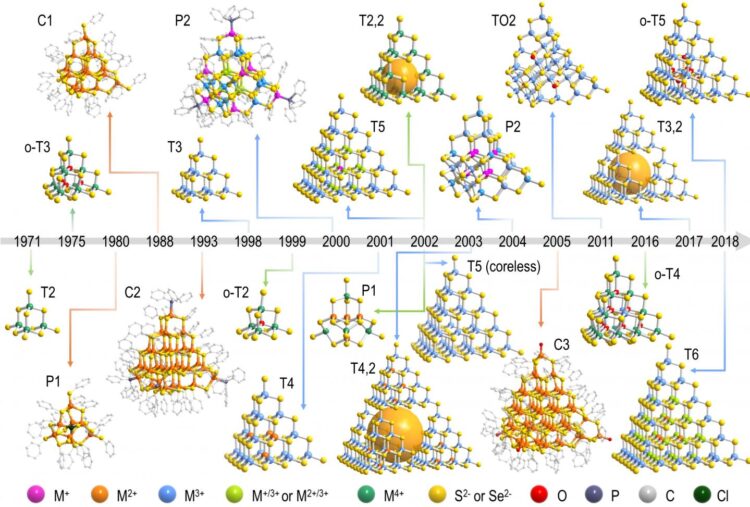Nanoclusters, which consist of several or even thousands of atoms, represent an important intermediate state between microscopic atoms and macroscopic matter. A profound comprehension of the composition, structure, and properties of nanoclusters is crucial for exploring or extending their functional applications. Among the numerous types of nanoclusters, metal chalcogenide supertetrahedral clusters (MCSCs) have attracted great attention since the 1980s for their uniform sizes, well-defined structures, and semiconductor properties. Notably, because of their resemblance to II-VI or I-III-VI semiconductor nanocrystals (also known as quantum dots, QDs), MCSCs have been regarded as atomically precise ultrasmall QDs and used to clarify various issues that could not be resolved using traditional QDs, such as the determination of precise site-dependent structure-property relationships.
Generally, research on MCSCs can be categorized into three topics: (1) expansion of the architecture of crystalline MCSC-based frameworks through fabricating clusters with di?erent sizes/compositions and modifying intercluster connecting modes, (2) discretization of MCSCs in the lattice and their solution processability, and (3) exploration of the composition-structure-property relationships, functionality and applications of MCSC-based crystals. Based on this, the development history of metallic chalcogenide supertetrahedral clusters was systematically summarized from the following four aspects:
1) Development of MCSCs: types and sizes
MCSCs can be subdivided into three types: 1) basic-supertetrahedral Tn clusters; 2) cap-supertetrahedral Cn clusters; 3) penta-supertetrahedral Pn cluster. In addition, Tn clusters can further induce a series of pseudo-Tn clusters, including Tn (coreless) clusters, oxychalcogenide o-Tn clusters, super-supertetrahedral Tp,q clusters, etc. Synthetically, the construction of MCSCs is actually a “game” of charge-balance, that is, the coordination of M-E (S, Se or Te) must follow the Pauling’s electrostatic valence rule to achieve the local charge balance within the cluster, and the high overall negative charge of the cluster must be compensated by the external counter cations to achieve the overall charge balance. As the MCSCs’ size increases, the local and overall charge balance become more and more complex. Therefore, how to expand the size and type of MCSCs has always been the focus of researchers and the difficulty to be solved.
2) Construction of MCSC-based semiconductor open frameworks
The development of MCSC-based open framework materials is intended to solve the restriction of oxide zeolite in photoelectricity due to their inherent insulation. A large number of porous semiconductor materials with unique topological structures and properties have been developed due to the fact that MCSCs are easily assembled with the corner sulfur sharing modes. However, such assembly mode gradually shows the disadvantage of “bottleneck” in the construction of new structures. Researchers began to explore organic ligands and transition metal atoms as a new pattern of intercluster connection modes. This innovative idea not only expands the structures of MCSC-based semiconductor open frameworks, but also enrich the functionality of those materials.
3) Discretization of MCSCs in superlattice and dispersability in solvents
Since the discretization of MCSCs (mainly Tn clusters) in the superlattice is the premise of obtaining real molecular nanoclusters, researchers have successfully realized the discretization of Tn clusters in the superlattice by combining the strategy of “multivalent metal complementarity” and the “superbase-assisted crystallization”. In this regard, high-valent metal ions tend to distribute at the corner sites, which greatly controls the coordination ability of the corner S, usually resulting in the discretization of clusters. The introduction of superbase is easy to form a high concentration of counter cations in the mother liquid, which can effectively stabilize the polyanionic clusters. In addition, the selected superbase have an approximately in-plane molecular configuration, which is helpful to make them co-crystallize with the cluster. Notably, the incorporation of a large amount of high-valent metal ions inevitably decreases the negative charge of the individual clusters and weakens the electrostatic interaction between the cluster and the organic counter cations, thus favoring crystallization and subsequent dispersion.
4) Atomically precise site-dependent properties
Due to the site-selective distribution of multi-valent metal ions in the clusters, Tn clusters can be regarded as the excellent structural models to study the dopant-dependent structure-property correlation. In the case of T5 (coreless) clusters, the missing metal sites in the central region can be occupied by other metal atoms through post-modification or precise doping. The doping of a single copper ion can significantly improve the photoelectric response of T5 clusters. The photoluminescence behavior of Mn ions can be studied by doping Mn ions into T5 (coreless) clusters. The co-doping of Cu and Mn ions can realize the single-crystal white emission. In addition, the mechanism of electrochemiluminescence can be explored by using the precise structure model with central vacancy site and Mn doping site.
###
This work was supported by the National Natural Science Foundation of China
See the article:
Jiaxu Zhang, Pingyun Feng, Xianhui Bu, and Tao Wu
Atomically precise metal chalcogenide supertetrahedral clusters: frameworks to molecules, and structure to function
Natl Sci Rev; doi: 10.1093/nsr/nwab076
https:/
The National Science Review is the first comprehensive scholarly journal released in English in China that is aimed at linking the country’s rapidly advancing community of scientists with the global frontiers of science and technology. The journal also aims to shine a worldwide spotlight on scientific research advances across China.
Media Contact
Tao Wu
[email protected]
Related Journal Article
http://dx.





